Shortly after we moved to Indiana in 1998, Mike was arranging a visit to an office in a nearby town. His colleague there gave him directions that included “go past the big cemetery”. He received similar instructions for several other destinations. Mike used to say that no matter where you were going in southern Indiana, you had to go by a graveyard.
You might not have a cemetery on your travel itinerary, but the Cemitério de Agramonte (Agramonte Cemetery) has been a fascinating destination for us. It was one of the first “not in the tour books” locations we discovered. We have visited it several times since we moved here. It is a place that is both peaceful and somber at the same time.
The Cemitério is close to the Praça de Mouzinho de Albuquerque, also known as the Rotunda da Boavista, where we walk our dog almost every day.
A Bit of History
The Agramonte Cemetery was hastily opened in 1855 to serve as a burial place for victims of a cholera epidemic. It was the second public cemetery in Porto. (The first was in the Lapa area, a few kilometers away.) Over time it has been modified and improved. The chapel was built in 1870 and expanded in 1906. Three religious orders maintain private cemeteries within the walls of Agramonte – the Order of Carmo , São Francisco and Trindade.
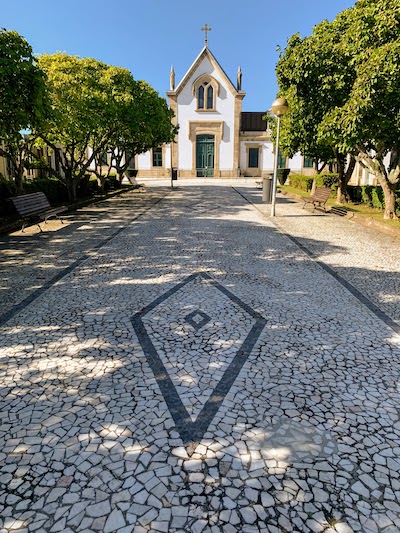
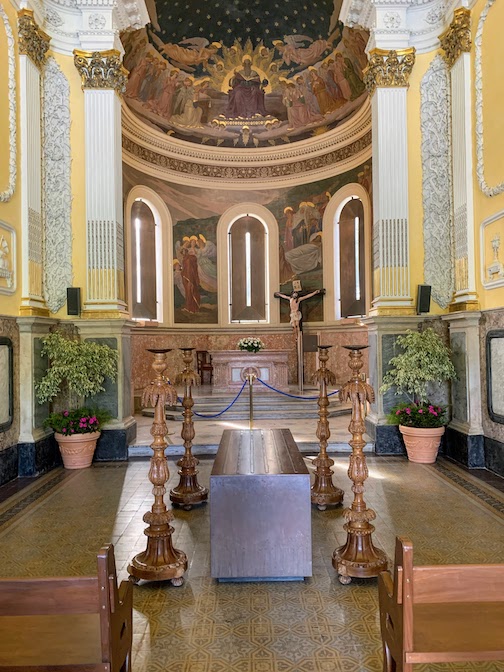
What You See at Agramonte
The first thing you notice as you approach the Cemitério de Agramonte is the high stone wall that surrounds the property. This is a holdover from earlier times when walls were built around cemeteries to prevent animals from getting in and disturbing the graves. Agramonte is 12 hectares, approximately 30 acres, and is walled all around.
Inside the cemetery walls, the landscape looks different from most graveyards in the US.
Professor Francisco Quieroz, of the Escola Superior Artistica do Porto, wrote several papers about the history and art of Portuguese cemeteries. In one paper, he described the concept that drove the design of “modern” cemeteries in the mid-1800’s. According to Professor Quieroz,
Today, the most important cemeteries are considered museums, as very important places of history and art. Oporto cemeteries, specially those described in this guide, perfectly fit into this pattern. In fact, the most important 19th century Portuguese cemeteries, also called romanticist cemeteries, were conceived to be galleries of remarkable men, pantheons of noble families, archives made of masonry and ironwork. Its pompous mausoleums reflect a particular attitude towards death, so emphasized in the 19th century: the preservation of one’s memory. Therefore, each of the following cemeteries became a place of memory and a “city of the dead”, containing some of the same paradoxes and virtues from all the other cities.
That description – “city of the dead” – articulates, in a way that we could not, what’s different about the cemetery. Everywhere you look, you see above ground tombs – freestanding mausoleums of various sizes. They sit along wide paths, like streets. Each one has a number, like an address.
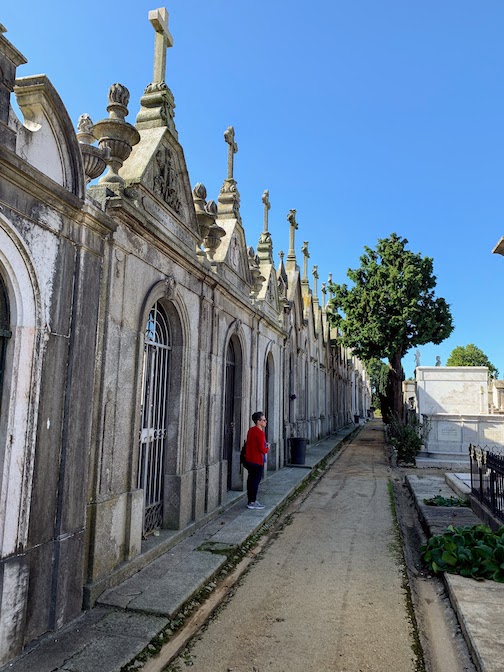
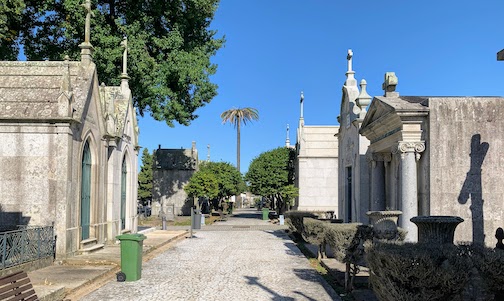
Some of the mausoleums are small, simple buildings. Others are more ornate, reflecting the wealth and stature of the persons laid to rest in them. A few of them clearly illustrate the definition of “pompous”.

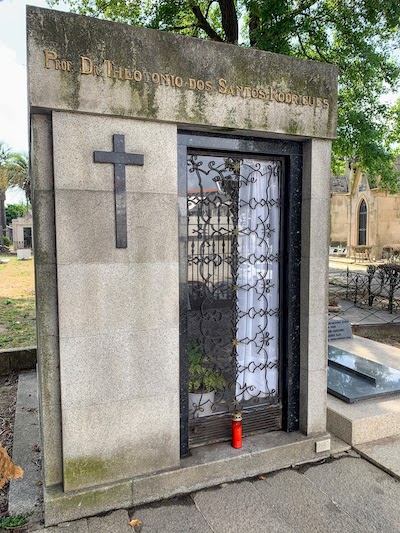
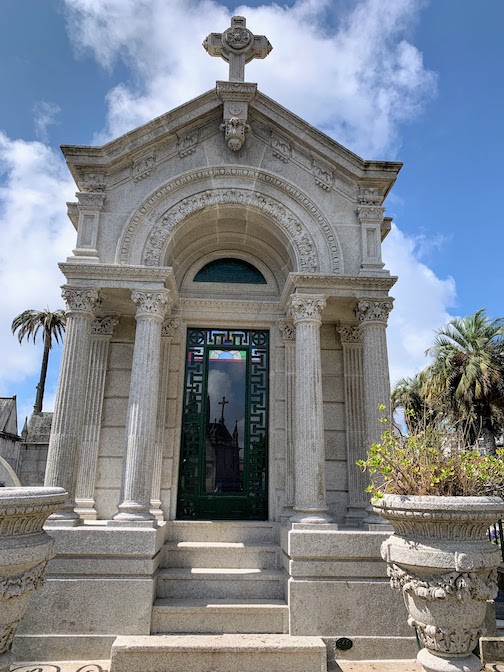
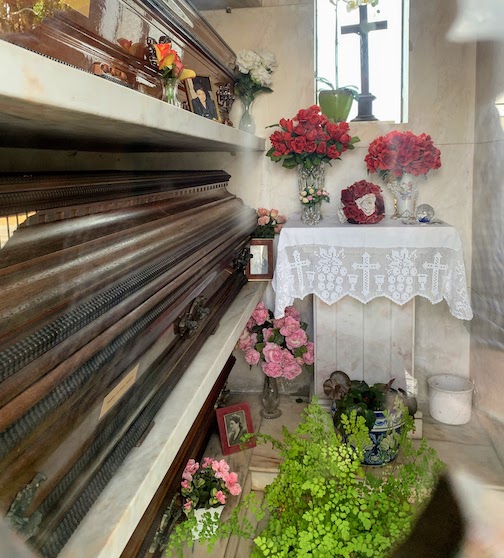
Many of the tombs have wrought iron doors with glass panels. When you look inside, you often see another striking thing – caskets resting on on thick shelves. Some are covered with cloth. Some are enclosed in stone vaults, but many sit out in the open.
The small rooms sometimes have shelves holding vases of flowers, crosses and bibles. Some have stained glass windows. In one, Mike saw a box that looked like a portable file cabinet. He said, “It figures. You just can’t escape paperwork!”
Other Sights
The cemetery grounds and most of the tombs are well maintained. Every time we visited, we have seen lots of activity. Women in blue smocks carry buckets of water to wash the stones and fill pots holding flowers on the graves. They collect the burned out candles and throw away the dead flowers. City employees cut the grass and rake leaves. One morning we saw workers installing a new roof on a tomb.
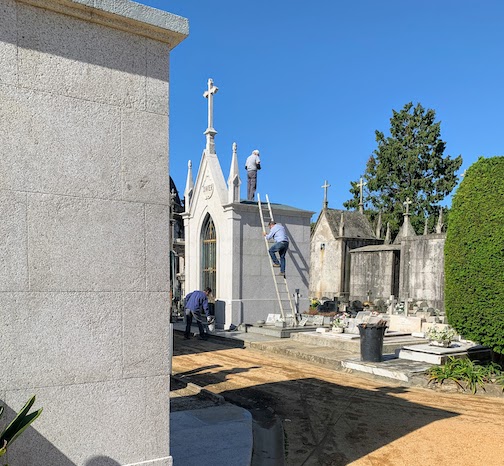
Other burial plots do not have mausoleums. Instead, they have graves covered with stone or marble that contain the remains of multiple family members. Some have elaborate decorations. Some have tombstones. Others have smaller placards with names, dates and occasionally pictures of the deceased. All of them remind us that, even in death, the family unit is a strong part of Portuguese culture.
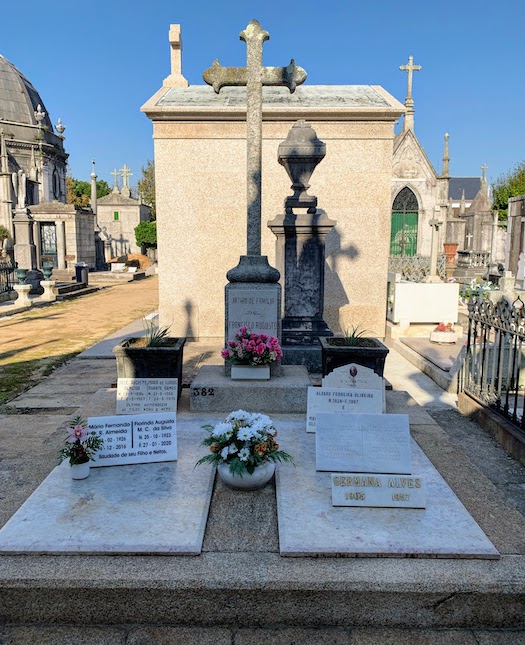
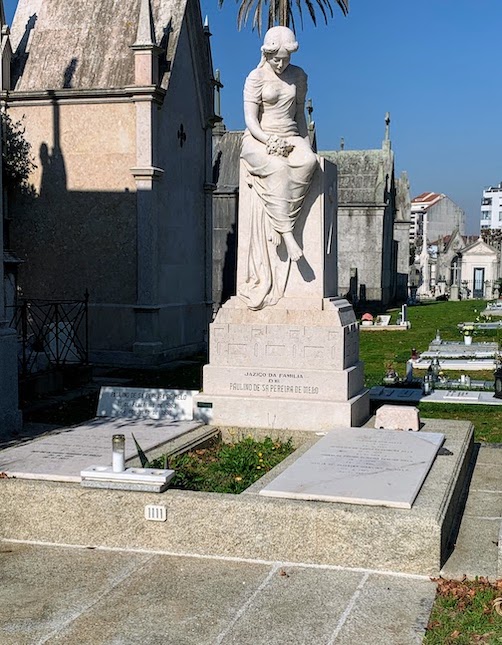
Sadly, some of the tombs have fallen into disrepair, with windows broken or stone ornaments fallen to the ground. It appears that the buildings have outlasted the fortunes of the families who built them.
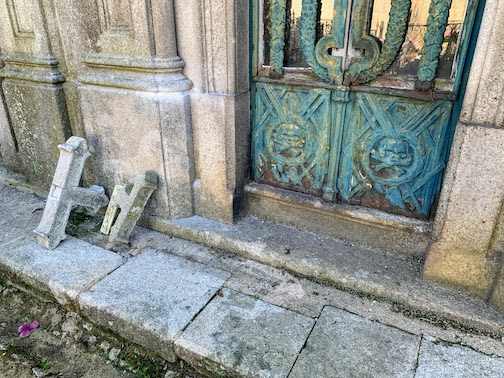
A Striking Memorial
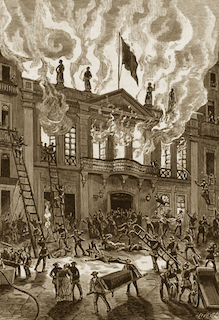
On March 20, 1888, a fire destroyed the Teatro Baquet, the Baquet Theatre, in Porto. A year earlier, the Porto facilities inspector had recommended that the theater be upgraded to create better safety conditions. But those recommendations were ignored. 120 people died in the fire.
A memorial to the victims of the fire was constructed in the cemetery. Much of it is made from materials taken from the ruined theater – pieces of iron twisted by the fire. Atop the memorial is a wreath, also made from damaged metal. A sign beside the memorial indicates that it is a tomb where the victims of the fire rest.
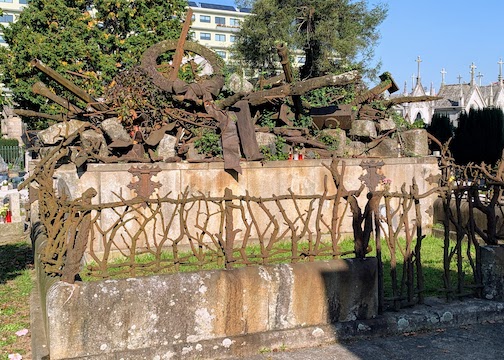
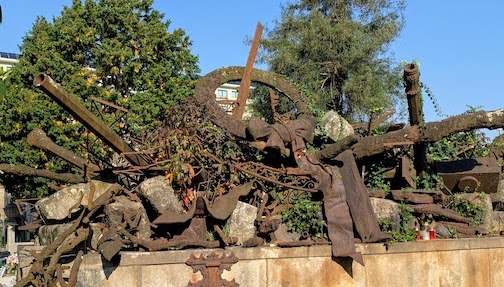
Some Final Reflections
It is quiet and peaceful in the Cemetério Agramonte. Sitting on a bench in the sun on a warm afternoon is very pleasant. The inhabitants don’t make much noise. But their monuments tell us much about their hopes, aspirations, and how they viewed themselves in the world.
And perhaps, while we listen to the silence in the cemetery, what we learn from them will help us get a clearer focus on the priorities for our own lives.
Where do you go to find peace and quiet in a noisy world? Leave us a comment below or send on in via the Contact Form.
All our best / Todos os nossos melhores
Mary and Mike
The Cook and The Writer
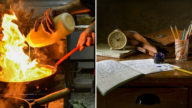


Hi, Mike & Mary! I’m finally catching up on your blog posts but still waaaay behind. Not sure if you’ll see my comment here this late in the game, but, just in case you do, I can’t let this post go by without commenting. 🙂 Visiting cemeteries is one of my favorite things to do, weird as that might sound. We try to visit them wherever we travel. When we met you guys in Hermann, Missouri, years ago, we stopped by their cemetery after we said goodbye to you. You might recall, Hermann was founded by German immigrants, and many of the headstones there are all written in German. I found one monument stone carved with a skull and crossbones (as I *think* I noticed on one of the graves in your photos here), which seems just a bit macabre for a grave! 😮 Our latest cemetery visit was in Philadelphia in October, where we saw the grave of Ben Franklin. So much history in cemeteries, including many markers with the death year of 1918 which you might have noticed, too. Makes me wonder what future generations will think when they see so many with the years 2020 and 2021 🙁 …but hopefully not as many dated 2022!! Thanks for another very interesting blog post, among your many interesting posts. 🙂
Thanks for this great article. I also enjoy visiting cemeteries in various cities as it shows an incredible history of the people who came and went before us. In the state of Washington, they have an area where the cemeteries are by nationality. You have the Russians buried in this section and the Irish buried over in this section and so forth. The saddest are the graves of the children. I feel like I’m discovering Portugal through the eyes of Mike and Mary, and I love it! Do you have an actual mailing address? Keep writing and cooking, miss you. Jana
Hello,
I enjoyed this blog and especially appreciate the history given. I wrote a blog a couple of. months ago about an experience I had here in a Porto cemetery. Thought I would share it: https://www.world-wanderer.com/blog/locked-in-a-cemetary
Thanks for the great blog posts!
Ellen
Hi Mike and Mary, just an FYI. We were watching Sunday Morning as always. It’s a program on CBS with Jane Pauley every Sunday. They had a story on Portugal and the Covid vaccine. If you can, try and see it.
I very much enjoyed your description of the cemetery, so much so that I will visit it next week. I have been to the famous cemetery in Buenos Aires where Evita is buried and also toured a cemetery in Croatia. Cemeteries are indeed very interesting places to visit!
Mike and Mary ~
My favorite post to date.
Take good care,
Nan
So interesting and beautiful in its own way. The only cemetery tour we ever took was in New Orleans. Famous with all above ground tombs. We also visited the Jewish Ghetto and cemetery in Rome. My grandparents and aunts and uncle are in a Jewish cemetery in PA and there are lots of pictures on the gravestones. Interesting. Keep enjoying!
Beautiful summary and write up on Cemetério Agramonte!